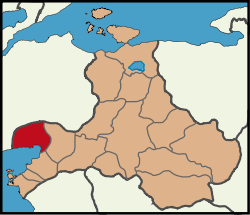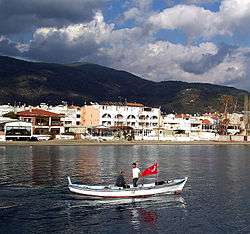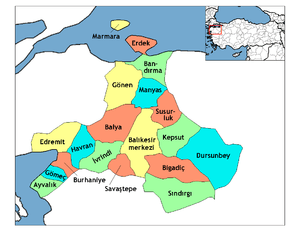Edremit, Balıkesir
| Edremit | |
|---|---|
|
Altınoluk resort center near Edremit | |
 | |
 Edremit Location of Edremit within Balıkesir Province | |
| Coordinates: 39°35′32″N 27°01′12″E / 39.59222°N 27.02000°ECoordinates: 39°35′32″N 27°01′12″E / 39.59222°N 27.02000°E | |
| Country |
|
| Region | Aegean |
| Province | Balıkesir |
| Government | |
| • Mayor | Kamil Saka (CHP) |
| Area[1] | |
| • District | 731.32 km2 (282.36 sq mi) |
| Population (2012)[2] | |
| • Urban | 55,255 |
| • District | 127,459 |
| • District density | 170/km2 (450/sq mi) |
| Time zone | EET (UTC+2) |
| • Summer (DST) | EEST (UTC+3) |
| Postal code | 10x xx |
| Licence plate | 10 |
| Website | http://www.edremit.bel.tr |
Edremit (Ottoman Turkish: ادرمد) is a district in Balıkesir Province, Turkey, as well as the central city of that district, on the west coast of Turkey, not far from the Greek island of Lesbos.
It is situated at the tip of the gulf with the same name (Gulf of Edremit), with its town centre a few kilometers inland, and is an important center of trade, along with the other towns that are situated on the same gulf (namely Ayvalık, Gömeç, Burhaniye and Havran). It is also one of the largest district centres of Balıkesir Province. The district of Edremit, especially around Kazdağı, is largely covered with forests.
History
Classical Period
The modern city of Edremit is named after the ancient city of Adramyttion (Άδραμύττιον) or Adramytteion (Άδραμύττειον) or, in Latinised form Adramyttium, a city of Asia Minor on the coast of Aeolis. The site where Adramyttion sits was originally settled by Leleges, the indigenous inhabitants of the Aegean littoral, and people from the neighbouring region of Mysia.[3] Following the Dorian invasion, in c.11-8th centuries BC, Aeolians from Thessaly settled this area and gave their name to the region of Aeolis.[3] Adramyttion is mentioned in the Iliad as one of the cities sacked by Achilles during the Trojan War. Achilles captured Chryseis, daughter of a priest of Apollo, at Adramyttion and engifted her to Agamemnon, the leader of the Greeks.[4][5]
Adramyttion was founded in the 6th century BC as an Lydian settlement and named after its founder Adramys or Adramyttes, son of Alyattes, King of Lydia.[3][6] Cimmerians invaded this region but were defeated and driven out by Alyattes.[3] Croesus, son of Alyattes, was archon (lord) of Adramyttion prior to succeeding his father as the last King of Lydia.
Adramyttion was conquered and annexed by the Persian Empire in 546 BC and formed part of the newly formed Satrapy of Lydia. In 477 BC, it is thought that Adramyttion allied itself with Athens against the Persians and joined the Delian League.[7] During the reign of Xerxes I, administrative reforms moved the city to the Satrapy of Hellespontine Phrygia in 477 BC. Adramyttion became home to Greek exiles from Athens and Delos in 422 BC on the invitation of Pharnaces II, the Persian satrap (governor) of Hellespontine Phrygia.[8][9][10][11] Adramyttion was sacked and its population massacred in 411 BC by a Persian army led by Arsakes, a subordinate of Tissaphernes, satrap of Lydia and Caria, for not paying outstanding tribute to the Persian Empire.[12] The city probably became Hellenised in the late 5th century BC.[13]
As recorded in his Anabasis, Xenophon and the Ten Thousand passed through Adramyttion in 399 BC whilst travelling to Mysia.[14] By the late 4th century BC, the city had been fully Hellenised.[12] In 366 BC, Ariobarzanes, satrap of Phrygia and acting satrap of Hellespontine Phrygia, joined the Great Satraps' Revolt and withstood a siege at Adramyttion from Mausolus, satrap of Caria, and Autophradates, satrap of Lydia. The port at Adramyttion was built in the early 3rd century BC.[15]
Adramyttion came under the sway of the Attalid dynasty of Pergamon during the rule of Eumenes I,[16] and formed part of the Kingdom of Pergamon until the death of its last king, Attalus II, in 133 BC, upon which he bequeathed his kingdom to the Romans thus forming the Roman province of Asia; Adramyttion acted as the centre of its own district within the province.[17] In April 88 BC, during the First Mithridatic War, Adramyttion allied itself with Mithridates VI, King of Pontus, against the Romans.[18] Diodorus, a local philosopher-statesman sympathetic to Mithridates, was elected general and had several prominent pro-Roman members of the boule (council of citizens) and the entire senate executed.[19] Spurred on by Mithridates VI and his supporters, in what became known as the Asiatic Vespers, Roman settlers in Adramyttion and Asia Minor were massacred by the local population in May.[20] At the end of the war, Xenocles, a talented local orator, was sent to Rome to defend Adramyttion and the province of Asia from accusations of supporting Mithridates before the Roman Senate.[21][19]
In the 1st century AD, Adramyttion is noted to be the seat of a conventus iuridicus by Pliny the Elder in his encyclopaedia, Natural History.[19] The city was damaged by a destructive earthquake in the 2nd century AD and the areas damaged were subsequently rebuilt by Trajan.[3] It was to this port that the ship belonged on which the author of the Acts of the Apostles (probably Luke the Evangelist) and Paul the Apostle set out from Caesarea Maritima for the first part of their journey to Rome.[22] The ship, which appears to have been a coastal trading vessel, conveyed them only to Myra, in Lycia, whence they sailed on an Alexandrian ship for Italy. Some scholars have argued that St. Paul travelled to Rome from Adramyttion itself, but this has since been disregarded.[23] Adramyttium became the seat of a Christian suffragan diocese of the Metropolitan Archbishopric of Ephesus, the Roman Catholic Diocese of Adramyttium, which only remains as a Latin Catholic titular see. Adramyttion became part of the Eastern Roman Empire, later known as the Byzantine Empire, in 395 AD.[7]
Mediaeval Period
The administrative reforms of the 7th century in the Byzantine Empire moved Adramyttion into the new theme of Thrakesion in which it served as an important naval base.[24] Prior to becoming emperor, Theodosius III lived and worked in Adramyttion as a tax collector. Theodosius was proclaimed emperor by the army of the theme of Opsikion in May 715 but, according to the chronicler Theophanes the Confessor, was reluctant to become emperor and hid in the surrounding forests where he was forced to become emperor.[25]
The city's importance ensured it later belonged to the Theme of Samos upon its creation between 843 and 899 and became the seat of one of the two tourmarches or commander of a tourma, a major subdivision of a theme.[24] The interior surrounding the city was under the jurisdiction of a separate tourmarches based in Adramyttion, subordinate to the strategos (governor) of Thrakesion in the 9th century at least.[24]
Adramyttion was raided and destroyed by the Turkish pirate Tzachas in 1093 but was rebuilt and repopulated with people from the surrounding countryside in 1109 by Eumathios Philokales, the strategos of the Cibyrrhaeot Theme.[13] A large force of nomad Turks who attempted to retake the city were defeated and its camp captured.[26] During the Second Crusade, in 1147, French crusaders passed through Adramyttion whilst travelling to Ephesus.[27] Despite the city's destruction, Adramyttion continued to serve as an important military base and became part of the theme of Neokastra,[28] founded by Manuel I Komnenos between 1162 and 1173, and was its capital from 1185 onwards.
Adramyttion was plundered by Genoese pirates in 1197.[17] After the Sack of Constantinople in 1204, Adramyttion was captured by Henry of Flanders, brother of Latin Emperor Baldwin I of Constantinople, in early 1205. An attempt to retake the city by the Byzantine successor state, the Empire of Nicaea, was led by Constantine Laskaris and culminated in the Battle of Adramyttium on 19 March 1205 in which the Byzantines were resoundingly defeated. The Byzantine usurper Theodore Mangaphas also attempted to conquer the city not long after the attempt made by the Nicaeans, but was also defeated by Henry.[29]
By 1304, Adramyttion and other coastal cities were the only regions of Asia Minor that remained under Byzantine control.[7] Adramyttion fell to the Karasid Turks in September 1334,[7] under whom the city was known as Edremit. Whilst occupied by the Karasids, Yahsi Bey of Saruhan built several hundred barques at Edremit.[14]
Modern Period
Tahtacı Turkmens, descendants of the army of Shah Ismail I, settled in the mountains near Edremit after their defeat in the Battle of Chaldiran in 1514.[4] By 1819, Adramyttion continued to occupy its ancient site on the coast and was known as Adramiti. According to Henry Alexander Scammell Dearborn, Adramiti was only populated by "a few Greek fishermen".[23]
In May 1914, thousands of Muslim refugees who had fled from the Balkans arrived in the town of Edremit and proceeded to ransack the shops and homes of the town's Greek community. According to Arnold J. Toynbee, the Ottoman government armed and organised the refugees. Many Greeks found refuge in the town church before fleeing to the harbour where they were then granted passage to the neighbouring island of Lesbos. Turks continued to massacre or evict Greeks in the following months in surrounding villages.[30] The Greek army occupied the town on 19 June 1920 but withdrew in late August 1922 and all remaining Greeks fled or were killed by the Turkish army.[17]
Location
Debate exists as to when Adramyttion moved to its current site at Edremit. The ancient city was on the coast, 13 kilometres southwest of the modern city and 4 kilometres west of Burhaniye.[31] According to Wilhelm Tomaschek, Adramyttion moved to the site of modern Edremit under Trajan, however, it has been argued that there was no cause for this during Trajan's rule as piracy, the sole cause for such a move, was negligible.[13] Kiepert argued that this move took place in 1109 after the city's destruction in 1093 at the hands of Tzachas, however, scholars note that it is not stated in contemporary sources that the city was rebuilt inland.[13] It has also been argued that the relocation of Adramyttion took place after its destruction by Genoese pirates in 1197.[17]
Edremit continued to sit on the coast at its ancient site until at least the early Ottoman period.[14]
Economy
Edremit's economy relies largely on the production of olives, as well as on tourism. Edremit is known as the olive capital of Turkey. Kaz Dağı National Park, extending around the ancient Mount Ida (mentioned in Homer's epic poems such as the Iliad), is situated within the boundaries of Edremit district and is an important tourist attraction with its natural scenery and a number of picturesque small villages around it.
Demographics
In ethno-cultural terms, the population of Edremit is a mixture of Balkan Turks, descendants of immigrants from Balkans, Aegean Islands, some Circassians, as well as Tahtacı Turkmens, who pursue their own traditions and life-style to this day. A private museum of ethnography in the village of Tahtakuşlar is one of the rare institutions in Turkey focusing on Tahtacı culture.
Notable people from Edremit
- Theodosius III (lived in Adramyttion in 715 AD, Byzantine emperor
- George Mouzalon (born in Adramyttion in 1220, Byzantine Greek megas domestikos)
- Benjamin I of Constantinople (born in Adramyttion in 1871, Ecumenical Patriarch of Constantinople)
- Panos Dukakis (born in Adramyttion in 1896, father of American politician Michael Dukakis)
- Sabahattin Ali (Author-Journalist)
- Hülya Avşar (born in Edremit in 1963, father from Ardahan)
- Caner Erkin (born in Edremit in 1988)
- Melodi Kızılgün-Sopata (Cosplayer)
Twin towns — Sister cities
Edremit is twinned with:
 Amaliada, Greece since 2000
Amaliada, Greece since 2000 Kamp-Lintfort, Germany since 2009
Kamp-Lintfort, Germany since 2009 Erdenet, Mongolia since 2010
Erdenet, Mongolia since 2010 Nicolosi, Italy since 2010 [32]
Nicolosi, Italy since 2010 [32]
References
- ↑ "Area of regions (including lakes), km²". Regional Statistics Database. Turkish Statistical Institute. 2002. Retrieved 2013-03-05.
- ↑ "Population of province/district centers and towns/villages by districts - 2012". Address Based Population Registration System (ABPRS) Database. Turkish Statistical Institute. Retrieved 2013-02-27.
- 1 2 3 4 5 International Journal of the Physical Sciences Vol. 5 (2010), pp. 876-883
- 1 2 Rosie Ayliffe, The Rough Guide to Turkey (2003), p. 294
- ↑ Dana Facaros, Michael Pauls, Turkey (2000), p. 211
- ↑ James Orr, The International Standard Bible Encyclopedia (2015)
- 1 2 3 4 Recep Efe, Munir Ozturk, Shahina Ghazanfar, Environment and Ecology in the Mediterranean Region (2012), pp. 63-64
- ↑ Eckhard J. Schnabel, Early Christian Mission: Paul & The Early Church (2004), p. 1147
- ↑ William Smith, Dictionary of Greek and Roman Geography (1854): "Adramyttium"
- ↑ Gustav Hirschfeld, "Adramytteion" in Paulys Realencyclopädie der classischen Altertumswissenschaft, Vol. I,1, Stuttgart 1893
- ↑ Alexander Kazhdan (editor), The Oxford Dictionary of Byzantium (Oxford University Press, 1991, 3 vols., ISBN 0195046528) vol. 1, 227, s. v. Atramyttion
- 1 2 S. Douglas Olson, Fragmenta Comica: Eupolis frr. 326-497 (2013), p.188
- 1 2 3 4 Walter Leaf, Strabo on the Troad: Book XIII, Cap. I, Book 13 (1923), p.323
- 1 2 3 John Freely, The Western Shores of Turkey: Discovering the Aegean and Mediterranean Coasts (2004), p. 64
- ↑ Leaf (1923), p. 267
- ↑ Carlos A. Picón, Seán Hemingway, Pergamon and the Hellenistic Kingdoms of the Ancient World (2016), p. 34
- 1 2 3 4 Kiminas 2009, pp. 81.
- ↑ Adrienne Mayor, The Poison King: The Life and Legend of Mithradates, Rome's Deadliest Enemy (2009), p. 157
- 1 2 3 John-Anthony Cramer, A Geographical and Historical Description of Asia Minor (1832), pp. 127-128
- ↑ Mayor (2009), p. 16
- ↑ H. G. Bohn, The Geography of Strabo, Volume 2 (1856), p. 387
- ↑ Acts 27:2
- 1 2 Henry Alexander Scammell Dearborn, A Memoir on the Commerce and Navigation of the Black Sea: And the Trade and Maritime Geography of Turkey and Egypt, Vol. 2 (1819), pp.51-52
- 1 2 3 John W. Nesbitt, Nicolas Oikonomidès, Catalogue of Byzantine Seals at Dumbarton Oaks and in the Fogg Museum of Art: West, Northwest, and Central Asia Minor and the Orient (1996), p. 23
- ↑ Michael F. Hendy, Studies in the Byzantine Monetary Economy C.300-1450 (2008), p. 658
- ↑ George Finlay, A History of Greece (2014), pp. 124-125
- ↑ Hendy (2008), pp. 107-108
- ↑ Hendy (2008) p. 131
- ↑ Magoulias (1984), p. 331.
- ↑ Giles Milton, Paradise Lost: Smyrna 1922, pp. 48-50
- ↑ Mordtmann, J. H.; Ménage, V. L.. "Edremit." Encyclopédie de l’Islam. Brill Online, 2014. Reference. 30 September 2014
- ↑ Sister/Twin Cities of Balıkesir Province
Literature
- Kiminas, Demetrius (2009). The Ecumenical Patriarchate: A History of Its Metropolitanates with Annotated Hierarch Catalogs. Wildside Press LLC.
External links
| Wikimedia Commons has media related to Edremit. |
![]() This article incorporates text from a publication now in the public domain: Easton, Matthew George (1897). "Adramyttium". Easton's Bible Dictionary (New and revised ed.). T. Nelson and Sons.
This article incorporates text from a publication now in the public domain: Easton, Matthew George (1897). "Adramyttium". Easton's Bible Dictionary (New and revised ed.). T. Nelson and Sons.

